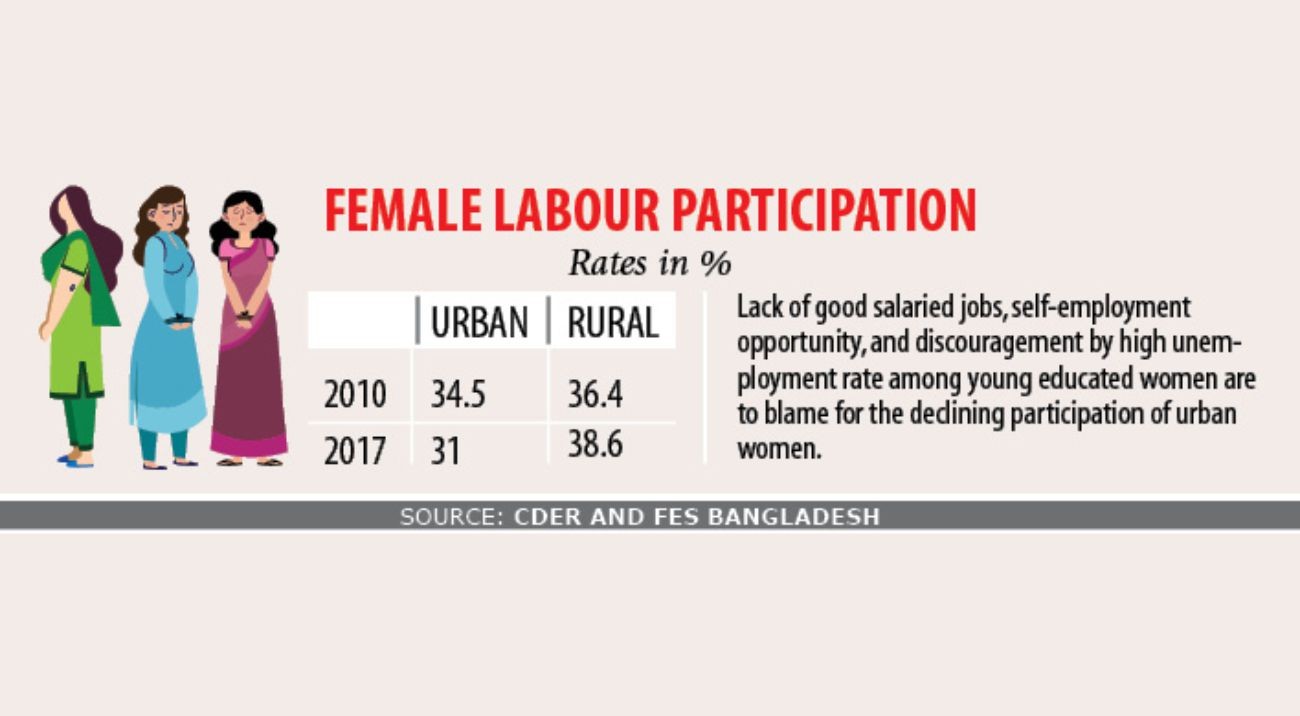Women employment falling in urban areas

The number of women working in urban Bangladesh has been declining since 2010 but it is the opposite in case of rural women, according to a report released yesterday.
In 2010, urban female participation rate was 34.5 percent, which came down to 31 percent in 2017.
In contrast, in rural Bangladesh the ratio rose to 38.6 percent from 36.4 percent, according to the report ‘Employment, Labour Force Participation and Education: Towards Gender Equality in Bangladesh’.
The Centre for Development and Employment Research (CDER) and the FES (Friedrich-Ebert-Stiftung), Bangladesh launched the report at an event held at Dhaka’s Brac Centre Inn.
The report attributed the declining participation of urban women on the lack of good salaried jobs, self-employment opportunity, and discouragement by high unemployment rate among young educated women.
This phenomenon stands in contrast to the common notion that development and modernity lead to women’s employment, said Rushidan Rahman, executive chairperson of CDER. A number of factors have contributed to the decline in urban women participation.
“These are raising children, higher income of husband, social stigma etc.”
The rural women participation rate may have risen due to expansion of livestock industry and other activities based on microfinance, which depends mostly on female labour, she added. Generating non-farm self-employment requires skill and financial investment. But women barely have access to finance in urban area.
Moreover, a large majority of male workers are engaged in paid employment and therefore the scope of joint engagement of men and women is rather limited in urban areas, the report said.
The lack of availability of sufficient jobs suitable for women and high unemployment among them may have acted as a discouraging factor and that may reduce the labour force participation.
Youth male unemployment rate is 8.3 percent in 2017, whereas it is 15 percent for women.
Overall women’s participation in the labour force has been hovering around the 36 percent-mark in the last seven years though the participation rate increased to 36.3 percent from 23.9 percent during 2000-2017.
“There is no need to get frustrated about the lower participation rate of women because we have made a lot of progress in gender equality in the recent past,” said Qazi Kholiquzzaman Ahmad, chairman of Palli Karma-Sahayak Foundation. Once, women only worked at home but now they work both inside and outside of the houses.
“That does not mean we have no drawback in reducing gender inequality.”
Women need higher education rather than only primary or secondary education because women unemployment among the higher educated is very low.
A strategic approach is needed to know which training is needed for employees to keep up with future technologies.
Along with it, the government needs to focus on social capital and ensuring human rights for men and women, he added. Violence against women is one of the reasons behind the lowering female participation rate, said Pratima Pal Mojumdar, president of Karmojibi Nari.
On the other hand, mechanisation in the industrial sector reduces the need for labour, which ultimately lowers the women participation rate, she added.
Reducing early marriage and easing of child care responsibilities deserve policy support, the report said.
Increase in tertiary education and need-based skills training are needed too. Tina Marie Blohm, resident representative of FES Bangladesh; Hannana Begum, an economist; Md Shanawez Hossain, research fellow of BRAC Institute of Governance and Development; and Mohammad Harunur Rashid Bhuyan, research fellow of BIDS, also spoke.
